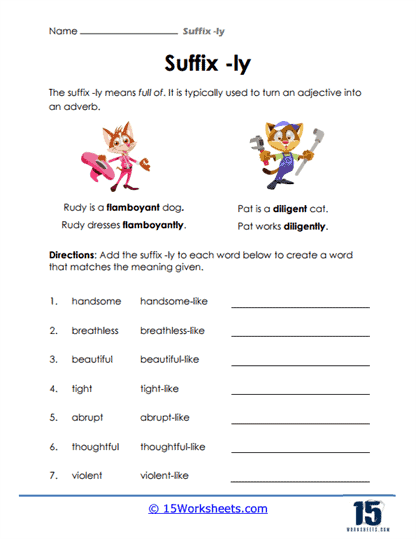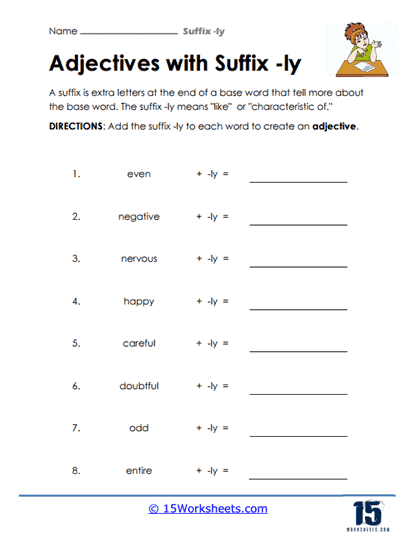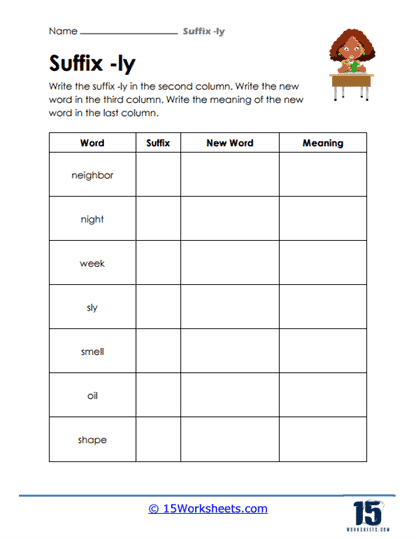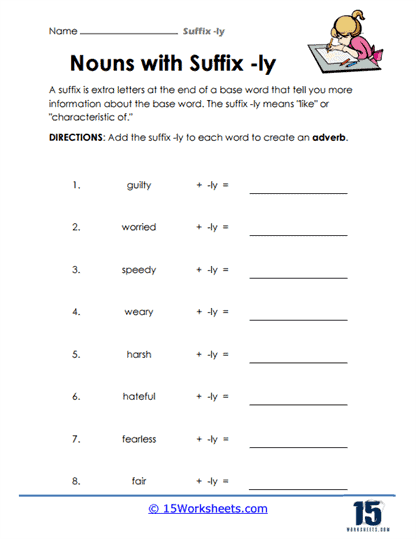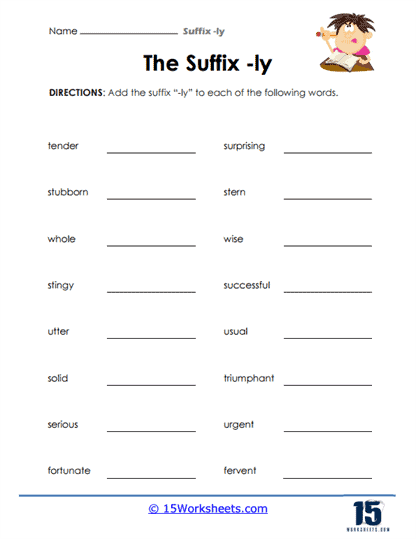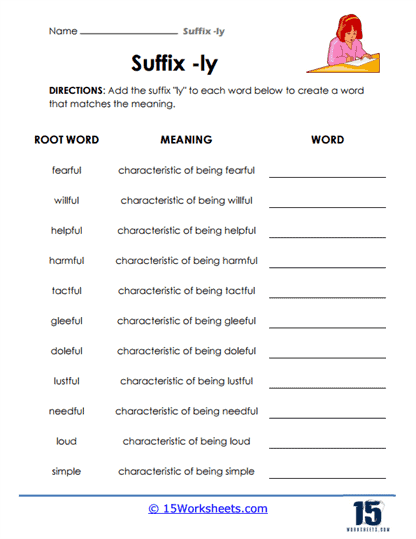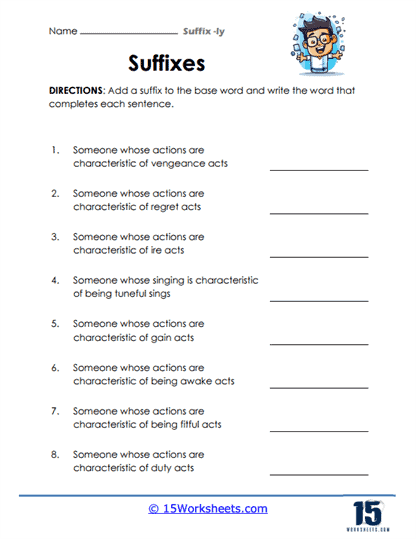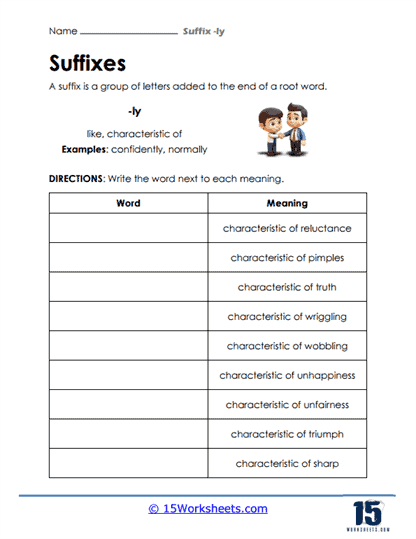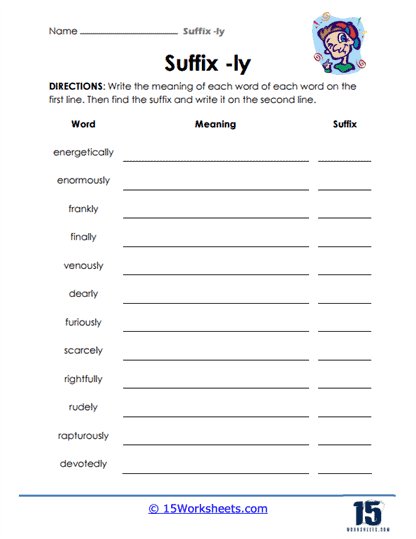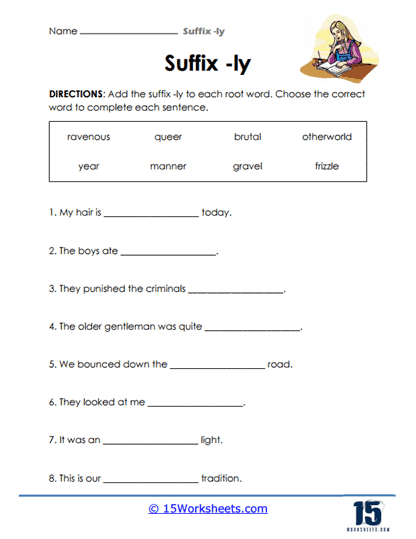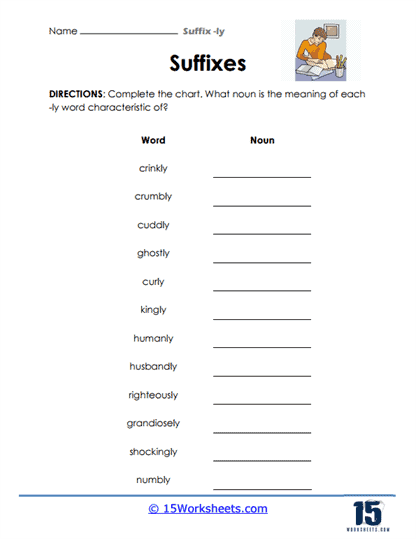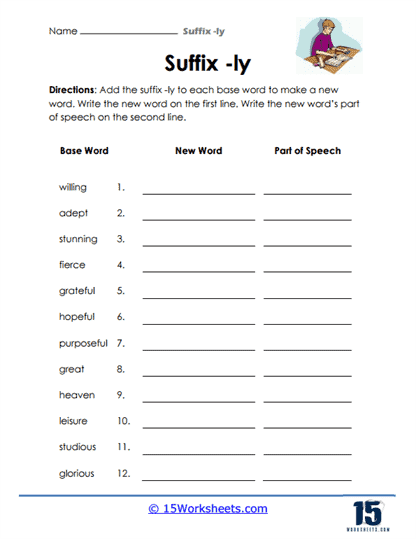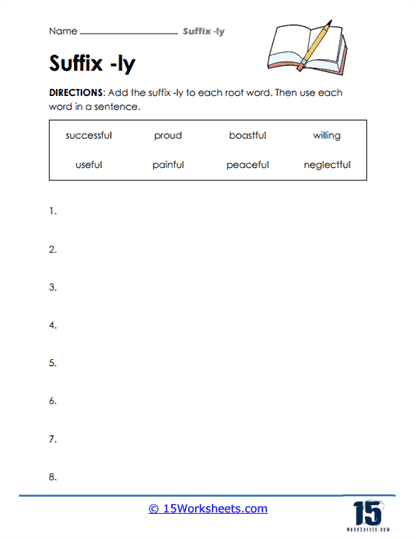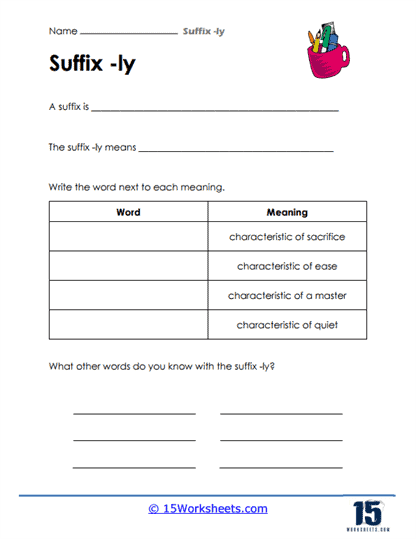Suffix -ly Worksheets
About These 15 Worksheets
Our suffix -ly worksheets will help students understand and apply the use of the suffix “-ly” in English grammar. The suffix “-ly” is a common ending in English that, when added to adjectives, turns them into adverbs, indicating how something is done. These worksheets contain a variety of exercises aimed at enhancing students’ grammar and language skills, particularly their ability to modify verbs with adverbs for more precise and descriptive writing.
Through a variety of exercises, these worksheets offer comprehensive practice in applying this grammatical rule, which in turn enhances students’ vocabulary, writing skills, reading comprehension, and overall understanding of English grammar. Regular practice with these worksheets equips students with the skills needed to communicate more effectively and creatively, laying a solid foundation for their future language learning endeavors.
Types of Exercises
1. Matching Adjectives to Adverbs – This exercise requires students to match adjectives with their corresponding adverbs ending in “-ly.” It helps students recognize how adding “-ly” to an adjective transforms it into an adverb. For example, “quick” becomes “quickly.”
2. Sentence Completion – In these exercises, students fill in the blanks in sentences with the appropriate “-ly” adverb. This practice helps them understand how adverbs modify verbs, adjectives, or other adverbs within a sentence, enhancing their sentence construction skills. Passages or short stories rich in adverbs ending in “-ly” are included for students to identify and analyze the use of adverbs. This enhances reading comprehension and analytical skills.
3. Conversion Practice – Students convert adjectives into adverbs by adding “-ly” and use them in their own sentences. This not only reinforces the rule of transforming adjectives into adverbs but also encourages creative sentence formation. Students might be asked to write short paragraphs or stories using a list of adverbs ending in “-ly.” This exercise encourages creative expression while practicing the grammatical concept.
4. Error Correction – Worksheets may contain sentences with incorrect use of the “-ly” suffix. Students must identify and correct these mistakes, which sharpens their editing and proofreading skills.
5. Comparative and Superlative Adverbs – Some exercises focus on teaching students to form comparative and superlative forms of adverbs (e.g., “quickly” to “more quickly” to “most quickly”). This helps students learn to express degrees of comparison in actions.
The Benefits of These Worksheets
1. Enhanced Vocabulary – Regular practice with these worksheets helps students expand their vocabulary. Learning to transform adjectives into adverbs by adding “-ly” enables them to express themselves more precisely and diversely.
2. Improved Writing Skills – By understanding how to use “-ly” adverbs to modify verbs and adjectives, students can write more detailed and descriptive sentences. This skill is crucial for creative writing, narrative essays, and descriptive paragraphs.
3. Better Reading Comprehension – Familiarity with adverbs ending in “-ly” helps students better understand texts they read. They become more adept at picking up nuances in meaning conveyed by the author through the use of adverbs.
4. Grammar and Syntax Knowledge – Working with suffix -ly worksheets reinforces knowledge of English grammar rules, such as adjective and adverb usage. This foundational knowledge is essential for mastering more complex grammatical structures.
5. Enhanced Editing Skills – Error correction exercises improve students’ ability to identify and correct grammatical mistakes, not only in their work but also in others’. This skill is valuable for peer reviews and self-editing.
6. Creative Expression – Exercises that involve creating sentences or stories encourage students to use their imagination while applying grammatical rules. This balance of creativity and technical skill makes learning more engaging and effective.
7. Confidence in Language Use – As students become more comfortable with using adverbs correctly, their confidence in writing and speaking English improves. This confidence can lead to better academic performance and more willingness to participate in class discussions.
Using the Suffix -ly
The suffix “-ly” is primarily used to form adverbs from adjectives, indicating manner, degree, or quality in relation to a verb, adjective, or another adverb. It’s added to the end of an adjective to modify it into an adverb, such as “quick” becoming “quickly” or “happy” becoming “happily.” However, not all adverbs end in “-ly,” so it’s essential to understand the specific rules and exceptions governing their usage in English grammar.
Rules For Using The Suffix -ly
The general rule for adding the suffix “-ly” is straightforward, there are specific spelling considerations and exceptions that must be understood to use it correctly in writing. Regular practice and exposure to various examples are crucial for mastering the proper usage of this suffix in English.
The spelling rule for using the suffix “-ly” primarily revolves around the manner in which it’s added to base words to form adverbs. While this rule is generally straightforward, there are some important guidelines and exceptions to consider:
Formation of Adverbs – The suffix “-ly” is added to adjectives to form adverbs, primarily indicating manner, degree, or quality in relation to a verb, adjective, or another adverb. For example:
Adjective – quick
Adverb – quickly
Spelling Considerations
Single Syllable Adjectives – When adding “-ly” to a single-syllable adjective, you typically just add the suffix without any spelling changes:
Adjective – slow
Adverb – slowly
Adjectives Ending in “y” – If the adjective ends in “y,” typically preceded by a consonant, the “y” is replaced with “i” before adding “-ly”:
Adjective – happy
Adverb – happily
Adjectives Ending in “le” – Adjectives ending in “le” usually drop the “e” before adding “-ly”:
Adjective – gentle
Adverb – gently
Adjectives Ending in “ic” – Adjectives ending in “ic” usually just add “-ally” to form the adverb:
Adjective – basic
Adverb – basically
Exceptions
Some adjectives have irregular forms when “-ly” is added:
Adjective – true
Adverb – truly
Some adjectives and adverbs don’t follow the pattern of adding “-ly” at all, like “fast” and “well.”
Some adverbs don’t end in “-ly” at all, such as “very,” “soon,” “now,” and “too.”
Hyphenation
In some cases, when “-ly” is added to an adjective that precedes a noun, a hyphen might be used to avoid ambiguity:
A friendly-looking dog
An awfully written book
Word Stress
In most cases, the stress in the adverb falls on the syllable immediately preceding “-ly”:
Quick –> QUICK-ly
Happy –> HAP-pi-ly

